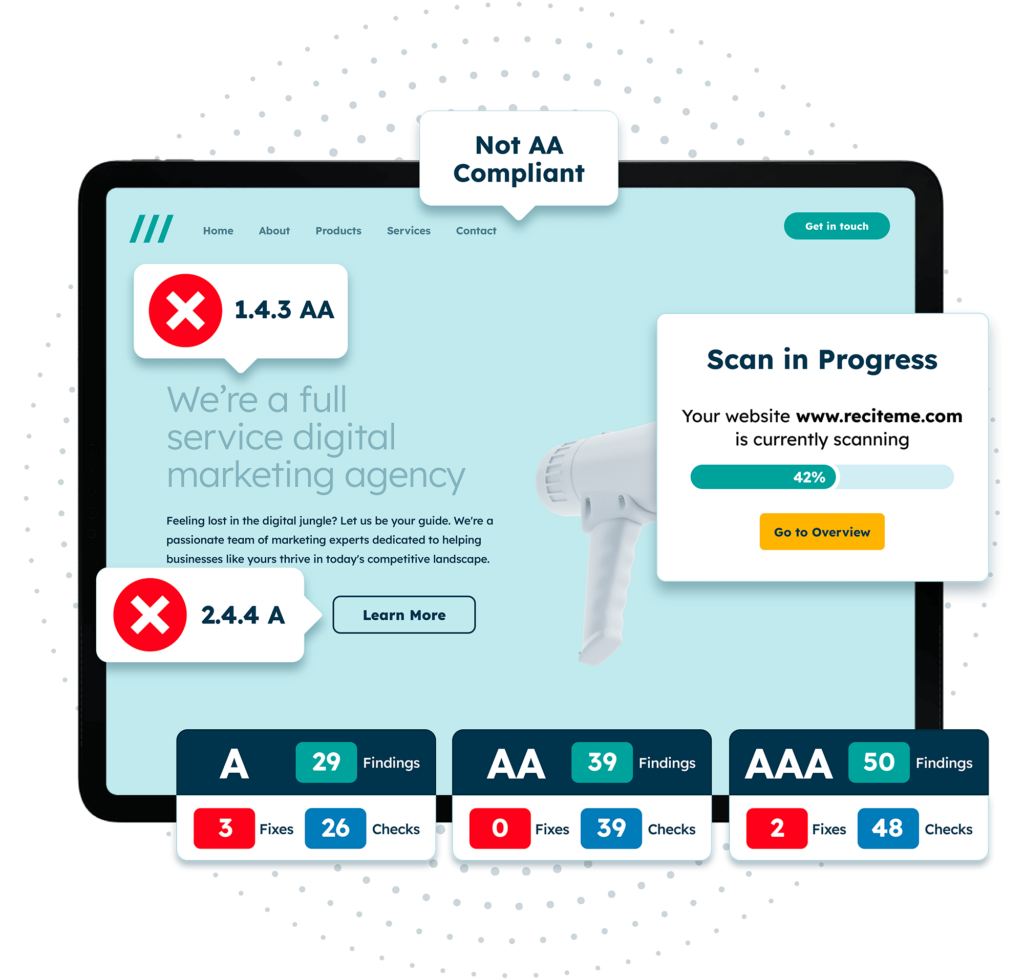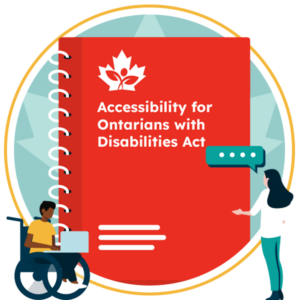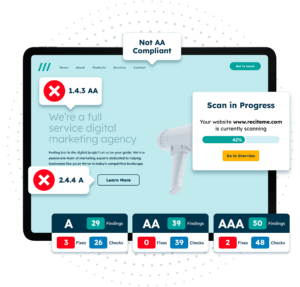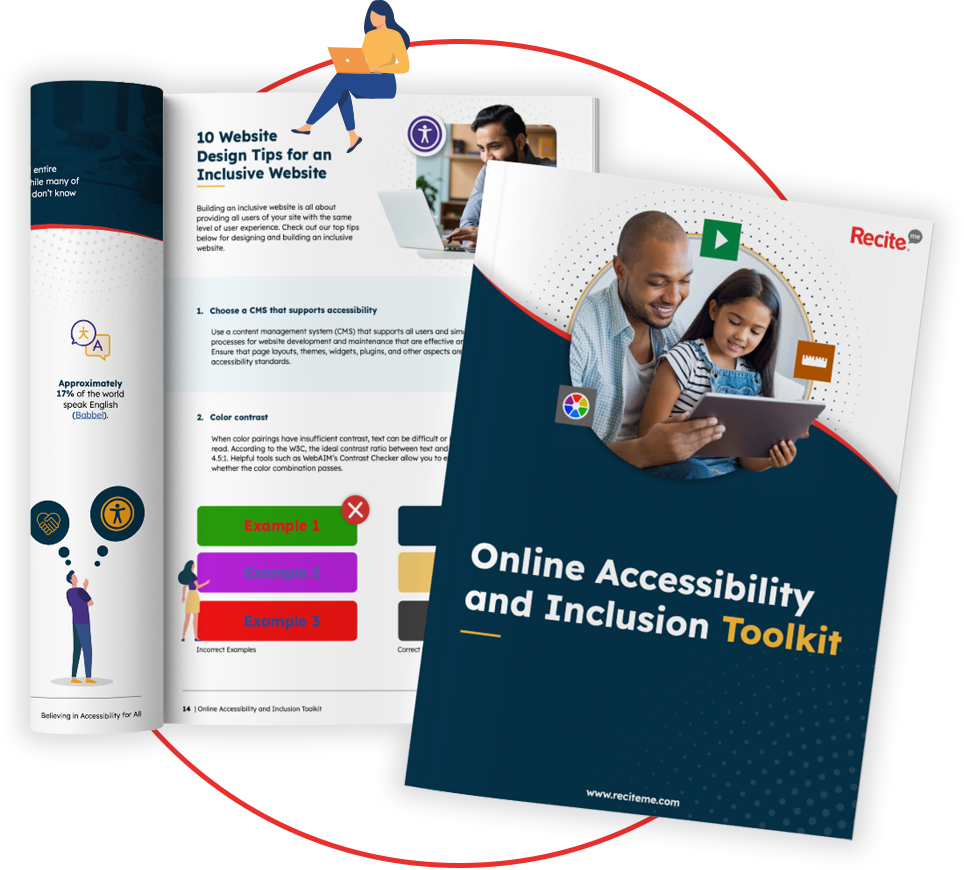Get Your Free Accessibility & Inclusion Toolkit
Download NowThe Accessibility for Manitobans Act (AMA) is an important piece of accessibility legislation in Manitoba, Canada. It covers accessibility across several key areas, encompassing both physical and digital accessibility.
If your organization operates in this area, you need to be aware of the requirements and strive for compliance. Don’t stay in the dark on accessibility. From non-profits to private businesses, we’ll explore everything you need to know about the AMA in this guide.
What is the Accessibility for Manitobans Act (AMA)?
The Accessibility for Manitobans Act (AMA) first became law in December 2013. This provincial legislation seeks to improve accessibility and prevent discrimination for disabled people in Manitoba. In fact, it was the second Canadian province to introduce this type of accessibility law, with the first being Ontario in 2005.
This act provides clear guidelines for identifying and removing existing accessibility barriers, and preventing new ones from cropping up. It seeks to ensure that disabled people can live fulfilling lives without discrimination in Manitoba.
These standards have been developed with contributions from disabled people and advocates, ensuring that those with lived experience were consulted. The AMA applies to digital accessibility, with Web Content Accessibility Guidelines 2.1 Level AA incorporated as a requirement for private and public sector organizations.


Who needs to be compliant?
The AMA applies to all public, private and non-profit organizations that employ at least one person. For example, this includes:
- Private sector businesses, such as restaurants and cafes, retail and ecommerce shops, professional services, etc.
- Non-profit organizations, such as charities, community organizations, and places of worship.
- Public sector organizations, such as federal agencies and departments, public educational institutions and universities, and Crown corporations.
Keep in mind that requirements vary between organization types and sizes, with full details available on the Manitoba Accessibility Office website.
Get a free automated accessibility check of your websites homepage. This will identify and highlight any compliance issues on your website. Followed by recommendations on how to implement the necessary changes to make your website more accessible.

What are the five accessibility standards of the AMA?
The AMA features five key accessibility standards that companies need to meet for compliance. Each sets out clear regulations for improving and maintaining accessibility in important areas. These five standards are:

1. Accessible Customer Service Standard Regulation
First established in late 2015, the Accessible Customer Service Standard Regulation provides guidelines for accessible customer service practices and training. It requires all organizations with one or more employees to develop customer service policies and practices that promote accessibility and prevent discrimination of disabled customers/clients. It applies to commercial businesses, as well as non-profits and public organizations.
2. Accessible Employment Standard Regulation
The second standard of the AMA, the Accessible Employment Standard Regulation, was enacted in May 2019. It aims to remove discriminatory barriers affecting employees and candidates, as well as preventing future barriers from arising. It covers a wide range of employment practices, from recruitment to retention.
Developing on The Human Rights Code (Manitoba), this regulation applies to paid employees. It’s applicable whether the employee is full-time, part-time, an apprentice, or a seasonal worker.


3. Accessible Information and Communication Standard Regulation
This regulation was enacted in May 2022, and is the most relevant to web accessibility. As it sounds, the Accessible Information and Communication Standard Regulation is centered around the removal and prevention of information and communication barriers. That includes digital and in-print information and communication, as well as any interaction involving people or technology.
It also provides specific web accessibility requirements. This requires organizations to ensure any web content that is new or required to access your goods and/or services is compliant with WCAG 2.1 Level AA at a minimum. This is also required for “new or significantly updated” web apps.
4. Accessible Transportation Standard Regulation
One of the more recent standards to be established, the Accessible Transportation Standard Regulation was enacted in early 2024. It’s due to come into force on January 1st 2027. This standard is focused on removing transportation barriers for disabled Manitobans, so they can participate fully in everyday life.
It applies to traditional and paratransit transportation providers, as well as vehicles-for-hire, schools, and municipalities. Requirements cover a wide range of relevant areas, including vehicle design, transport fares and operating times, and policy development.

5. Accessible Outdoor Spaces Standard Regulation
This standard is still in development. It will seek to enable disabled access to outdoor areas that are deliberately designed and constructed, such as sidewalks and parks. This will provide accessibility guidelines for these spaces that are not covered under the jurisdiction of the Manitoba Building Code.
Is the Accessibility for Manitobans Act enforceable?
Yes, the AMA is enforceable. If you or your organization is found guilty of a compliance violation, you may be subject to a fine of up to $250,000.

The Accessibility Compliance Secretariat is in charge of enforcing the AMA, as well as raising awareness about compliance, monitoring applicable organizations, and managing public accessibility complaints.
However, the secretariat uses a progressive compliance framework for managing violations. This means that punitive enforcement often is not the first point of action. Instead, the secretariat initially begins with raising the offending organization’s awareness of the accessibility requirements by sharing relevant resources and tools.
After this, if the organization or individual persists with willful non-compliance, they may then be subject to orders and financial penalties.
How does the AMA align with other Canadian legislation
The AMA is not the only accessibility legislation in Canada. There are both federal and provincial laws that seek to protect and enrich the lives of disabled Canadians, including online. But how do they compare to the Accessibility for Manitobans Act?
Accessible Canada Act (ACA)
The Accessible Canada Act (ACA) and the Accessibility for Manitobans Act (AMA) share a common purpose: to identify, remove and prevent barriers so people with disabilities can participate fully. The ACA creates federal standards and oversight across federally regulated sectors aiming for a barrier-free Canada by 2040, while the AMA establishes provincial standards, obligations and timelines for public and private organisations in Manitoba.
Both require stakeholder consultation, accessibility plans and reporting, and both use standards-based regulation to drive systemic change. Together they align in principles and mechanisms, operating at complementary federal and provincial levels to advance accessibility.

Other provincial regulations
Manitoba isn’t the only Canadian province with its own accessibility legislation. Others include:

Accessibility for Ontarians with Disabilities Act (AODA):
AODA applies to public, private, and non-profit entities in Ontario. It also has a set of 5 accessibility standards, which cover very similar areas to the AMA, including Information and Communications Standards.
It also uses WCAG standards for web accessibility, but requires version 2.0 instead of 2.1.
Accessible British Columbia Act (ABCA):
This is British Columbia’s accessibility legislation, and applies to several specific entities. These include educational institutions, school districts, health authorities, and public-sector companies.
Similar to AMA, compliance violations with the ABCA can set companies back by up to $250,000 in financial penalties.

How to make sure your website is accessibility compliant
The Accessibility for Manitobans Act requires compliance with the Web Content Accessibility Guidelines (WCAG) 2.1 Level AA. These globally-recognized standards ensure that your website and its content are accessible for all disabled people.

To ensure your website is WCAG compliant, you’ll need to conduct a website audit with a free web accessibility checker. This tool can analyse all your web pages, along with any uploaded PDFs and images. It then gives you a report with any required fixes, which are prioritized in a clear queue, so you know which to focus on first.
The checker compares your content against WCAG standards to enable your company to address the requirements of the Accessible Information and Communication Standard Regulation. It also gives you clear steps for how to address certain issues and, in some cases, quick AI-powered fixes to save you time.
Once this automated testing is complete, you should aim to follow up with a manual check to ensure no issues are missed. An accessibility checklist can be used to help make this an easy process.
Our 40-page Digital Accessibility & Inclusion Toolkit helps businesses break down online barriers and make a real impact. It offers practical advice on all aspects of digital accessibility, from writing an accessibility statement to accessible website tips and inclusive hiring.

Conclusion: Work towards AMA compliance before it’s too late
Digital accessibility is a cornerstone of the Accessibility for Manitobans Act, particularly as part of the Accessible Information and Communication Standard Regulation. So, if it applies to your organization, you cannot afford to ignore the accessibility of your website.
Uncovering potential compliance violations can be challenging. Fortunately, Recite Me has plenty of useful tools to simplify the process, including a free website accessibility checker and free color contrast checker. Plus, there are useful solutions, like the assistive toolbar for improved inclusivity. Get in touch with our accessibility experts for tailored solutions today.
Accessibility for Manitobans Act FAQs
Looking for a recap or quick summary? Here are a few of our most frequently asked questions to help you get to grips with the essentials:
What is the accessibility of Manitobans Act?
The Accessibility of Manitobans Act (AMA) is a provincial piece of legislation aimed at improving accessibility for disabled people. It includes detailed guidelines for identifying, resolving, and protecting against accessibility barriers in various areas of public life. It applies to public, private, and non-profit companies.
What is the Accessibility Act 2025 in Manitoba?
This refers to the Accessibility of Manitobans Act (AMA), a provincial law that aims to increase accessibility in Manitoba. From May 1, 2025, all businesses and non-profit companies (with a minimum of one employee) must meet the Accessible Information and Communication Standard Regulation, conforming to WCAG 2.1 Level AA.
What is the Manitoba Accessibility Grant?
This refers to the Manitoba Accessibility Fund (MAF), which offers one-off grants for projects to improve compliance and create awareness with the Accessibility for Manitobans Act (AMA). Eligible applicants include non-profits, local businesses, universities, and municipalities. Your application will need to support the AMA and meet fund objectives.
Who does the AMA apply to?
The Act applies to both the public sector (provincial government, municipalities, educational institutions, etc.) and the private and non-profit sectors in Manitoba.
What are organizations required to do under the AMA?
Requirements depend on the type and size of the organisation, but may include:
- Developing and publishing accessibility policies.
- Providing training for employees, volunteers, and management.
- Making reasonable accommodations for employees and customers.
- Reporting on accessibility progress.
How is Accessibility for Manitobans Act compliance monitored or enforced?
Organisations may be required to file accessibility compliance reports. The province can also investigate complaints, conduct audits, and issue orders or administrative penalties if organisations fail to comply.
What are the penalties for AMA non-compliance?
Failure to comply with the AMA can result in fines of up to $250,000, depending on the severity and frequency of the violation.



